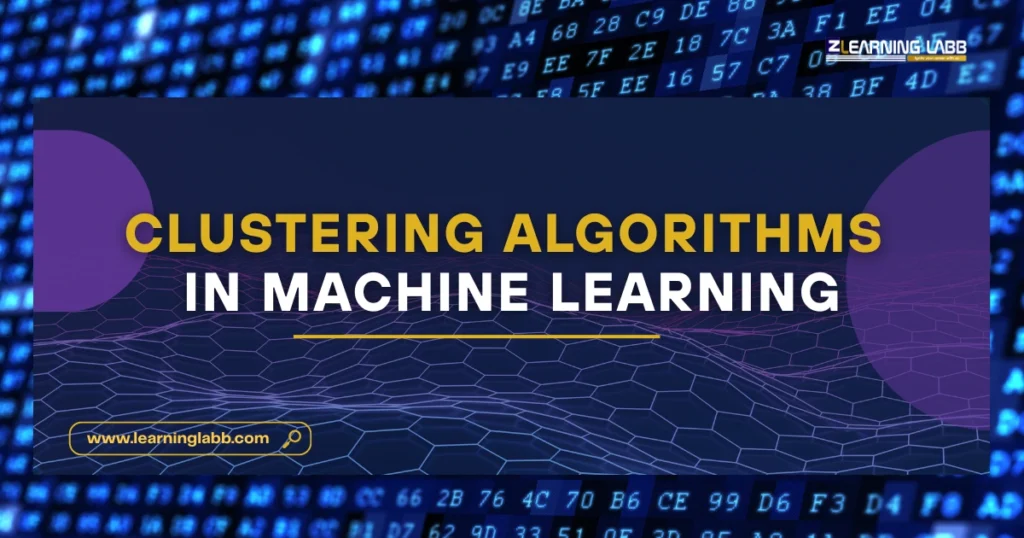Clustering algorithms in machine learning are like detectives, they quietly work in the background, looking for hidden groups and patterns in a sea of data. Unlike supervised learning, where labels are already provided, clustering deals with unlabelled data and tries to group it based on similarity.
This technique finds applications everywhere: from customer segmentation in marketing to grouping genes in bioinformatics, from fraud detection in banking to document organisation.
As Andrew Ng once said, “Unsupervised learning is the future of AI because the real world is unlabeled.”
Clustering stands tall as one of the most widely used unsupervised learning techniques.
What is Clustering Algorithm?
At its core, a clustering algorithm is a method that groups data points into clusters such that items in the same cluster are more similar to each other than to those in other clusters.
For example, think of an online store. The data shows buying behaviour of thousands of customers. Without knowing who buys what, a clustering algorithm can segment customers into groups: discount seekers, luxury buyers, regular shoppers, and seasonal visitors.
So, when people ask what is clustering algorithm? the simple answer is: it is an unsupervised learning technique used to group data without predefined labels.

How Clustering Algorithm Works
Understanding how clustering algorithm works is important before exploring its types. Here’s a simple breakdown:
- Define a similarity measure: Usually distance-based (Euclidean, Manhattan, cosine similarity).
- Choose the number of clusters (if required): Algorithms like K-means need this beforehand.
- Assign points to clusters: Based on their similarity to cluster centres or density of data points.
- Recompute cluster centres: The algorithm recalculates centres until the grouping stabilises.
- Stop when no significant change occurs: The final clusters represent hidden structures in data.
As you can see, how clustering algorithm works depends heavily on the chosen technique, which brings us to the types.
Read More: What is Cluster Analysis in Data Mining | Types, Applications, Examples
Types of Clustering Algorithms
There are multiple types of clustering algorithms, each with its own logic. Let’s break them down:
1. K-Means Clustering
- Divides data into k groups.
- Works well with large datasets.
- Sensitive to initial placement of centroids.
2. Hierarchical Clustering
- Builds a tree-like structure (dendrogram).
- Two types: Agglomerative (bottom-up) and Divisive (top-down).
- Doesn’t require pre-specifying the number of clusters.
3. DBSCAN (Density-Based Spatial Clustering of Applications with Noise)
- Groups points closely packed together.
- Can handle noise and outliers.
- Doesn’t require the number of clusters beforehand.
4. Gaussian Mixture Models (GMM)
- Assumes data comes from multiple Gaussian distributions.
- Assigns probabilities of belonging to clusters.
- More flexible than K-means but computationally expensive.
5. Mean-Shift Clustering
- Finds clusters by shifting data points towards dense regions.
- Good for irregular shapes but slower with large datasets.
Each of these types of clustering algorithms has unique strengths and weaknesses, which makes the comparison of clustering algorithms important.
Comparison of Clustering Algorithms
When performing a comparison of clustering algorithms, we look at factors such as scalability, accuracy, interpretability, and ability to handle noise.
| Algorithm | Pros | Cons | Best Used For |
| K-Means | Fast, simple, scalable | Needs number of clusters, sensitive to outliers | Customer segmentation |
| Hierarchical | No need for k, visual tree | Computationally expensive for big data | Small datasets, gene analysis |
| DBSCAN | Handles noise, finds arbitrary shapes | Struggles with varying densities | Spatial data, anomaly detection |
| GMM | Flexible, probabilistic clustering | Complex, slower | Image recognition, speech analysis |
| Mean-Shift | Works for irregular shapes | Not scalable for huge datasets | Image segmentation |
This comparison of clustering algorithms shows there’s no one-size-fits-all. The choice depends on data type and project goal.
Advantages and Disadvantages of Clustering Algorithms
Let’s balance the picture by seeing the advantages and disadvantages of clustering algorithms:
Advantages:
- Discover hidden patterns without labels.
- Useful for exploratory data analysis.
- Can work on high-dimensional datasets.
- Applicable in multiple industries.
Disadvantages:
- Performance depends on parameter tuning.
- Sensitive to noise and outliers (except DBSCAN).
- Computational cost can be high.
- Interpretation may be tricky when clusters overlap.
Learning about the advantages and disadvantages of clustering algorithms helps practitioners decide when to use them and when to look for alternatives.
How to Find Accuracy of Clustering Algorithm?
One common question is: how to find accuracy of clustering algorithm? Since clustering is unsupervised, accuracy isn’t straightforward like in classification. Instead, we rely on evaluation metrics:
- Silhouette Score: Measures how well data points fit within their cluster.
- Davies-Bouldin Index: Lower value means better clustering.
- Adjusted Rand Index (ARI): Compares clustering result with ground truth, if available.
- Calinski-Harabasz Index: Ratio of between-cluster dispersion to within-cluster dispersion.
So, when asked how to find accuracy of clustering algorithm, the answer is: by using these cluster validation metrics, not traditional accuracy percentages.

Clustering Algorithms in Machine Learning Python
Thanks to libraries like Scikit-learn, applying clustering algorithms in machine learning Python is straightforward.
Example with K-means in Python:
from sklearn.cluster import KMeans
from sklearn.datasets import make_blobs
import matplotlib.pyplot as plt
# Generate sample data
X, y = make_blobs(n_samples=300, centers=4, cluster_std=0.6, random_state=0)
# Apply KMeans
kmeans = KMeans(n_clusters=4)
kmeans.fit(X)
y_kmeans = kmeans.predict(X)
# Plot clusters
plt.scatter(X[:, 0], X[:, 1], c=y_kmeans, cmap=’rainbow’)
plt.scatter(kmeans.cluster_centers_[:, 0], kmeans.cluster_centers_[:, 1], s=200, c=’black’)
plt.show()
This small script shows how clustering algorithms in machine learning Python can be used for practical analysis. Similarly, DBSCAN, hierarchical, and GMM models are all available in Scikit-learn with easy-to-use functions.
On A Final Note…
Clustering algorithms in machine learning are a powerful way to uncover insights from unlabelled data. We started with what is clustering algorithm, walked through how clustering algorithm works, explored types of clustering algorithms, discussed comparison of clustering algorithms, highlighted advantages and disadvantages of clustering algorithms, understood how to find accuracy of clustering algorithm, and even implemented clustering algorithms in machine learning Python.
The bottom line? There isn’t a single perfect clustering technique. Instead, it is all about choosing the right algorithm for the right dataset.
As the saying goes, “Data is a precious thing and will last longer than the systems themselves.” And clustering is one of the ways to make that data truly meaningful.
FAQs
Q1. What are the most common types of clustering algorithms?
K-means, hierarchical, DBSCAN, GMM, and mean-shift are the most widely used.
Q2. How clustering algorithm works in simple terms?
It groups data points into clusters based on similarity, often using distance or density.
Q3. How to find accuracy of clustering algorithm?
By using metrics like Silhouette Score, Adjusted Rand Index, and Davies-Bouldin Index.
Q4. Which clustering algorithm is best?
It depends on the dataset. K-means is fast, DBSCAN handles noise, and hierarchical is good for small datasets.
Q5. Can we use clustering algorithms in machine learning Python easily?
Yes, libraries like Scikit-learn make it easy to apply clustering in just a few lines of code.





